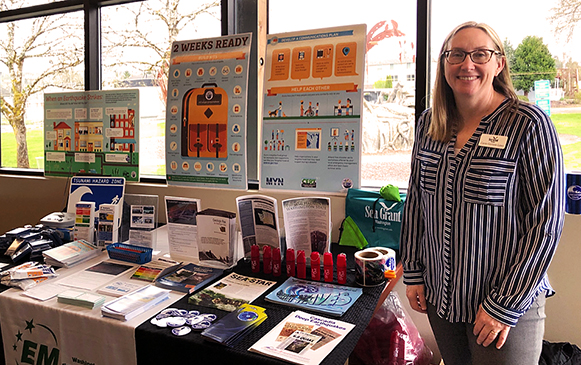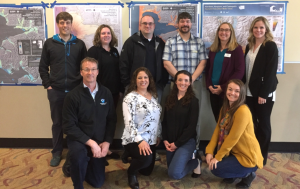May 13, 2019
Do you know what to do if a tsunami hits?
Officials from Washington Sea Grant, Washington Emergency Management Division, the National Weather Service and the Washington Geological Survey just wrapped the third year of the “Tsunami Roadshow.” The event brings experts and scientists to tsunami-vulnerable communities to discuss the science and dynamics of tsunamis, community-wide alerts, and tsunami survival strategies. This April, the roadshow visited the communities of Long Beach, Raymond, Aberdeen, Ocean Shores, Neah Bay (Makah Tribe), Port Angeles, and the Lower Elwha Klallam Tribe.

Carrie Garrison-Laney, Washington Sea Grant tsunami hazards specialist
The roadshow team explained that a Cascadia Subduction Zone earthquake poses serious threats to the Pacific Northwest, including the tsunami following a quake. The likelihood of a magnitude nine earthquake occurring in this zone in the next 50 years is 10 to 14 percent. After an earthquake, experts say residents on the outer coast will have only minutes to respond. This means people will need to be prepared – and act fast – to get out of their houses when the shaking stops.
Washington Sea Grant’s tsunami hazards specialist, Carrie Garrison-Laney kicked off the roadshow events with a geological and historical background of tsunamis. She shared her research and explained evidence of past tsunami. Garrison-Laney also insisted to the crowd that there is “always something you can do to improve your survivability in an emergency situation!”
The biggest “to do” emphasized this year? Don’t wait for an official tsunami warning! Following a Cascadia earthquake, Pacific coast residents will only have 15 to 20 minutes until a tsunami hits. Experts say if you feel long, strong shaking, act fast and don’t wait for a warning. In the event of a distant earthquake, it may be hours until a tsunami hits, so stay informed until the danger has passed. Be prepared for either case by signing up for tsunami alerts and having an evacuation plan. Since fast action will be critical, make sure to practice a planned on-foot evacuation route to high ground or as far inland as you can get. Visit the Washington Geological Survey’s tsunami hazard maps for your area to plan your route.
What about what not to do? First, experts urge residents not to underestimate the power of a tsunami. Even a tsunami only a few inches high can move cars and knock people over. Tsunamis are a series of many waves, and experts warn that the first wave is not always the biggest. For these reasons, it is essential to remain on high ground until the tsunami waves have dissipated. This could be up to 24 hours. That’s why it’s essential to have a “Go Kit” packed with warm waterproof clothes, sturdy shoes, a water filter, flashlight, first aid kit, non-perishable food, important documents (on a thumb drive) and a few items to lift your spirits during potentially challenging times.
Washington currently has 72 All Hazard Alert Broadcast sirens, which will be activated if a distant tsunami is on its way, and Governor Inslee’s budget proposed funding for another 15. However, these sirens may be damaged during a local earthquake, so don’t depend on them to warn you. “The earthquake is your warning,” Garrison-Laney said.

Back row L to R: Colby Neuman, Courtney Obergfell, Reid Wolcott, Maximilian Dixon, Carrie Garrison-Laney, Hannah Cleverly. Front row L to R: Tyree Wilde, Keily Yemm, Kiana Kabanje, and Corina Forson. Not pictured: Daniel Eungard.
Washington has North America’s only vertical evacuation structure at Ocosta Elementary near Westport, and a second is being built by the Shoalwater Bay Tribe. These structures are designed to withstand earthquakes and tsunamis, and provide a safe refuge for residents. At Ocosta Elementary, the structure is on the roof of the gym and can shelter at least 2,000 people. Future structures are planned and pending funding.
Washington has experienced large earthquakes and tsunamis in the past, and eventually will again. While we don’t know how big the next tsunami will be or when it will hit, we do know that being prepared to evacuate as high or as far inland as you can will give you the best chance of survival. Whether you live, work or vacation on the coast, we encourage you to be aware of whether you are in a tsunami hazard zone, and how you will evacuate if you feel a strong earthquake or receive a tsunami warning.
MAY
2019